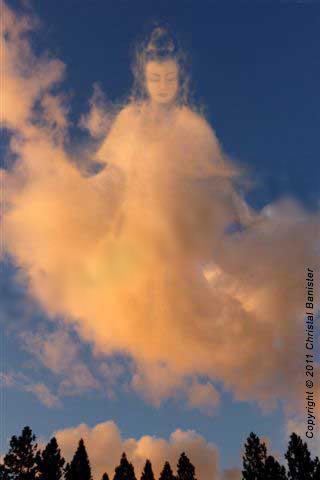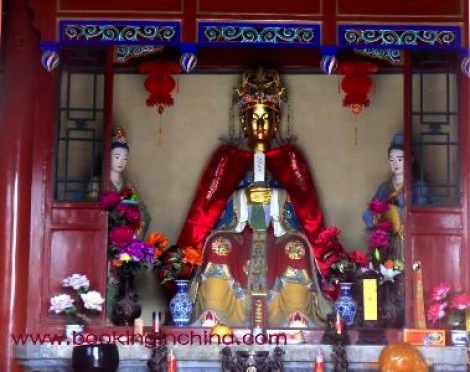
“Eagle Woman” by Susan Seddon Boulet
“Mother of All Eagles’ themes are freedom, perspective, overcoming, health, power, destiny, the Air Element and movement. Her symbols are feathers (not Eagle – gathering these is illegal). On the warm summer winds, Eagle Mother glides into our reality, carries us above our circumstances and stretches our vision. Among Native Americans, the Eagle Mother represents healing, Her feathers often being used by shamans for this purpose. Beyond this, She symbolizes comprehension, finally coming to a place of joyfully accepting our personal power over destiny.
On this day in 1982, President Reagan declared National Bald Eagle Day to honor the American emblem of freedom. In Native American tradition, this emblem and the Eagle Mother reconnect us with sacred powers, teaching us how to balance our temporal and spiritual life on the same platter.
Find a new, large feather for Eagle Mother talismans, one different from those you gathered for Maat, because the two have very different energies (check craft shops). Wrap the pointed end with cloth crisscrossed by leather thonging or a natural-fabric ribbon. Each time you cross the leather strings, say,
‘___________ bound within, when released by wind, let the magic being.’
Fill in the blank with the Eagle Mother attributes you desire, then have the feather present or used it in rituals or spells to disperse incense, thereby releasing its magic on the winds.”
(Patricia Telesco, “365 Goddess: a daily guide to the magic and inspiration of the goddess”.)

“Eagle Woman” by Susan Seddon Boulet
Michael Babcock says, “Despite the fact that the life-giving and death-wielding Bird Goddess is one of the oldest representations of the Goddess, eagles have usually been linked with the masculine, with a few exceptions (the Sphinx of Egypt had the wings of an eagle, and the Aztec Goddess Cihuacoatl was also called Eagle Woman [as was the Mayan Goddess Ix-Chel]). This Eagle Woman shows a new marriage of the feminine and the eagle. She represents all an eagle stands for: spirit, valor, majesty, renewal, accuracy of sight, spiritual aim, and the ability to soar to the heights. She also holds in Her hands a vessel, the traditional symbol for the feminine, for that which receives, contains, and nourishes. Here both sets of values are joined, emblematic of a different combination of strengths that are part of being woman-born.” [1]
The fearsome skeletal Aztec warrior Goddess, Itzpapalotl with Her wings and long claws also has some eagle attributes. [2]
“The golden eagle is…revered by the Huichol people living along the Sierra Madre Occidental mountains in the Mexican states of Jalisco and Nayarit. The Huichols call themselves Virarica (‘the healing people’) and are believed to have preserved the purest preColombian culture in our hemisphere. The golden eagle, Grandmother Eagle Goddess (Tate Warika Uimari) is guardian of the South (symbolizing the element of air, breath of life and healing). She is one of the guides into the Nierica (or passageway into the ‘other’ World) and connects the earth and sky.” [3]

As a totem, the eagle is associated with spirit, healing and creation.
“The eagle is symbol of the zenith.
A great reminder of your own ability to soar to great heights.
Those with an Eagle totem need to have an involvement with creation;
a willingness to experience extremes;
a willingness to use your ability
even if it means getting ‘scorched’ a little as you fly high;
a willingness to seek out your true emotions.
A demanding totem, but one that offers so much reward at the end of the journey.
Its four-toed feet remind you to stay grounded even went soaring high;
Its talons remind you to grasp the things of the earth;
Its sharp beak shows you when to speak, how much, and how strongly.
This totem will show you opportunities and how to ride the winds to your benefit.
Eagle people can live in the realm of the spirit
yet still remain connected and balanced within the realm of the Earth.
You must become much more than you ever dreamed possible.
Eagles are messengers from heaven and are the embodiment of the spirit of the sun.” [4]

From their Medicine Cards deck, Jamie Sams and David Carlson tell us that “Eagle medicine is the power of the Great Spirit, the connection to the Divine. It is the ability to live in the realm of spirit, and yet remain connected and balanced within the realm of Earth. Eagle soars and is quick to observe expansiveness within the overall pattern of life. From the heights of the clouds, Eagle is close to the heavens where the Great Spirit dwells.
 The feathers of Eagle are considered to be the most sacred of healing tools. They have been used for centuries by shamans to cleanse the auras of patients coming to them for healing. Within the belief systems of Native American tribes, Eagle represents a state of grace achieved through hard work, understanding, and a completion of the tests of initiation which result in the taking of one’s personal power. It is only through the trial of experiencing the lows in life as well as the highs, and through the trial of trusting one’s connection to the Great Spirit, that the right to use the essence of Eagle medicine is earned.
The feathers of Eagle are considered to be the most sacred of healing tools. They have been used for centuries by shamans to cleanse the auras of patients coming to them for healing. Within the belief systems of Native American tribes, Eagle represents a state of grace achieved through hard work, understanding, and a completion of the tests of initiation which result in the taking of one’s personal power. It is only through the trial of experiencing the lows in life as well as the highs, and through the trial of trusting one’s connection to the Great Spirit, that the right to use the essence of Eagle medicine is earned.
If you have pulled this symbol, Eagle is reminding you to take heart and gather your courage, for the universe is presenting you with an opportunity to soar above the mundane levels of your life. The power of recognizing this opportunity may come in the form of a spiritual test. In being astute, you may recognize the places within you soul, personality, emotions, or psyche that need bolstering or refinement.
By looking at the overall tapestry, Eagle teaches you to broaden your sense of self beyond the horizon of what is presently visible.
In learning to fiercely attack your personal fear of the unknown, the wings of your soul will be supported by the ever-present breezes, which are the breath of the Great Spirit.
Feed your body, but more importantly feed your soul. Within the realm of Mother Earth and Father Sky, the dance that leads to flight involves the conquering of fear and the willingness to join in the adventure that you are co-creating with the Divine.
If Eagle has majestically soared into your cards, you are being put on notice to reconnect with the element of air. Air is of the mental plane, and in this instance it is of the higher mind. Wisdom comes in many strange and curious forms and is always related to the creative force of the Great Spirit.

“Eagle Spirit” by Christian Riese Lassen
If you have been walking in the shadows of former realities, Eagle brings illumination. Eagle teaches you to look higher and to touch Grandfather Sun with your heart, to love the shadow as well as the light. See the beauty in both, and you will take flight like the Eagle.
Eagle medicine is the gift we give ourselves to remind us of the freedom of the skies. Eagle asks you to give yourself permission to legalize freedom and to follow the joy your heart desires.” [5]
Sources:
Babcock, Michael. Goddess Knowledge Cards, “Eagle Woman“.
Lin’s Domain, “Eagle“.
Sams, Jamie and David Carlson. Medicine Cards: The Discovery of Power Through the Ways of Animals, “Eagle Spirit“.
Spiritsong. “Golden Eagle“.
Wikipedia, “Itzpapalotl“.
Suggested Links:
Agaliha. Mystic Wicks, “Ix Chel {Goddess of the Week}“.
All Totems, “Eagle Spirit Meaning, Symbols, and Totem“.
Venefica, Avai. Whats-your-sign.com, “Symbolic Eagle Meaning“.














































